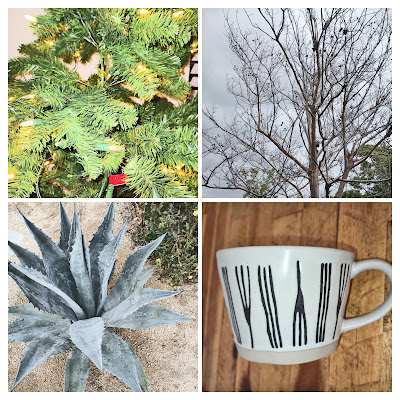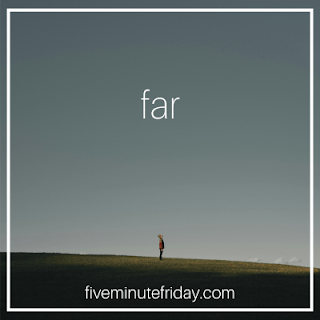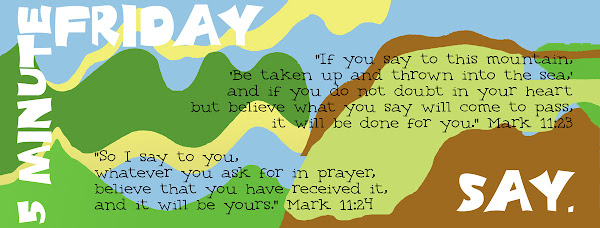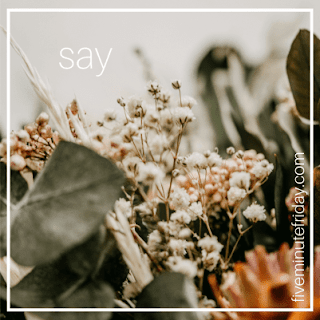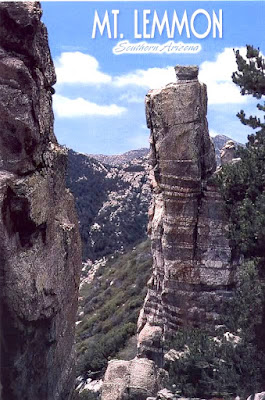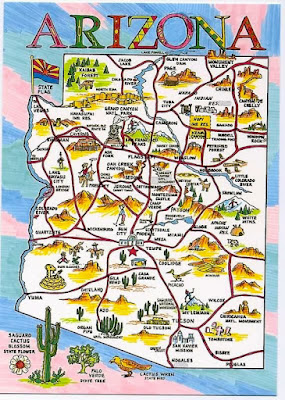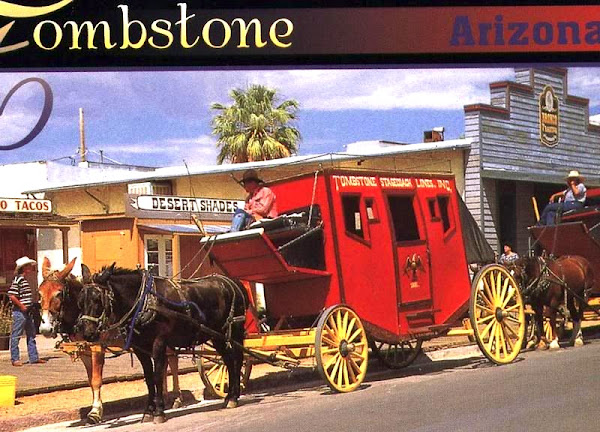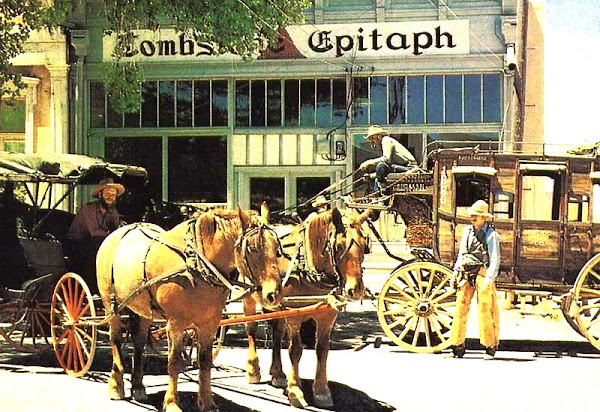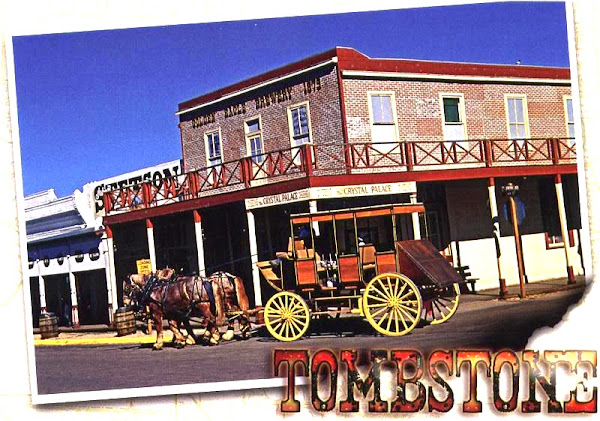• No January outings to historical places or tourist spaces, but I have some other pictures. • Sir Chives, one of my Housemates – Christmas Tree (it's still up with lights but without other decorations) – Poster in Social Space of the Church I've been attending – Succulent in Church Parking Lot • Christmas Tree Vignette – Tree Against Sky – Another Church Parking Lot Succulent – New! Contemporary Ceramic Cup • Cute Kitteh Cup – Chase, Another of my Housemates – Tree of Life Mural from Church – Unidentified (by me) Evergreen • Malinda's Seven Kittehs All Together
Wednesday, January 31, 2024
January 2024
• No January outings to historical places or tourist spaces, but I have some other pictures. • Sir Chives, one of my Housemates – Christmas Tree (it's still up with lights but without other decorations) – Poster in Social Space of the Church I've been attending – Succulent in Church Parking Lot • Christmas Tree Vignette – Tree Against Sky – Another Church Parking Lot Succulent – New! Contemporary Ceramic Cup • Cute Kitteh Cup – Chase, Another of my Housemates – Tree of Life Mural from Church – Unidentified (by me) Evergreen • Malinda's Seven Kittehs All Together
Friday, January 26, 2024
Five Minute Friday :: Far
• Five Minute Friday :: Far Linkup
This week's far prompt immediately evoked the parable of the Waiting Father / Prodigal Younger Son / Resentful Son in Luke 15:11-32 because more English translations than not tell us the younger son left home for a far country; you can review Luke 15:13 in different English versions on Bible Hub. As you'll notice, we get distant region, far country, distant country, distant land, foreign country, country far away from home, country far away.
With the letters far beginning or in the midst of many words, after I got curious about its etymology, I discovered "far" derives from Old English, Old Saxon, Old Frisian, Old Norse; it's related to Dutch, and it's from an Indo-European root shared by Sanskrit and Greek.
In whatever manner we use it casually, "far" is a great distance, way beyond, remote. Distant, beyond, remote from what or where? From home, from safety, from the familiar, from the expected.
On this Friday in late January 2024 I still feel far away from any normal I'd ever had, removed from the very minimum homecoming from exile I'd hoped for and trusted would happen. We have Luke's Prodigal (along with his Lost Sheep and Lost Coin Parables…). We know Israel's experience of exile and return to the Land of Promise only to encounter yet another empire, though amidst all the rebuilding and identity re-formation, Israel codified and canonized a great deal of what we know as the Hebrew Scriptures. Israel re-established worship. What does all that say about us and our being far away too often and sometimes even wanting to stay in the Far Zone because (come on, people, get real) it feels familiar and it feels safe?
If you offer to bring me near—why? Will we be close and not remote? Will you celebrate me or tolerate me? Will it be mutual homecoming, or like Israel, will I yearn for an Egypt that's now geographically far away? Will near be better than far?
Barbara Brown Taylor in Home by Another Way closely relates to our own experiences of far, of the prodigal son's homecoming, of each of our minor, major, traumatic, and secret departures from safety, from home, from the familiar. Her words resonate with times we go to far places on purpose or by accident, as well as our remote ways of being and acting that take us far from others and that distance us from the core of our identity:
What we may have lost along the way is a full sense of the power of God—to recruit people who have made terrible choices; to invade the most hapless lives and fill them with light; to sneak up on people who are thinking about lunch, not God, and smack them upside the head with glory.
Friday, January 19, 2024
Five Minute Friday :: Say
'Be taken up and thrown into the sea,'
and if you do not doubt in your heart
but believe what you say will come to pass,
it will be done for you." Mark 11:23
"So I say to you,
whatever you ask for in prayer,
believe that you have received it,
and it will be yours." Mark 11:24
• Five Minute Friday :: Say Linkup
In Mark's gospel, the journey to Jerusalem and to the cross is particularly incessant and relentless. Jesus' assuring teaching on the power of speech, word, and prayer (also in Matthew 21:21-22) happens during his final trip to the Holy City, after he has cleansed the temple and cursed a barren fig tree (another subject for another blog on another day).
Jesus and the twelve have been on a perilous journey together. When he called followers, he asked them to follow him. They left their family fishing enterprise with its conventional, pre-planned days and expected outcomes to follow Jesus, although they couldn't have known the future.
Even reading silently or aloud from Mark's pages, we can feel it had been quite a trip. Although Mark opens his gospel by announcing, "The beginning of the Good News of Jesus Christ, the Son of God," and close to the end, a Roman centurion declares Jesus "Son of God" [Mark 15:39], were there many or any clues along the way to suggest or affirm Jesus as God with them, God among us? We need to remember all the gospel accounts – even Mark, the earliest one – were written from scattered sources quite a while after Jesus' death and resurrection. In any case, back to say, our word for today.
Jesus is conversing about the power of speech, the effectiveness of words and communication. Would anyone want to send a mountain or a beachside cliff into the ocean? Hebrew literature long had been full of hyperbole! In the midst of your own turmoil, would you consider addressing an element of creation, suggesting it do your bidding? I don't know.
But I do know I love the "if - then" promises in this passage, especially pertaining to prayer.
• Do you pray without doubting?
• Do you say with believing?
• Do you pray knowing you've already received what you asked for?
• And do you then claim God's response as yours?
• You might enjoy this overview of Mark I wrote for my scripture blog.
Friday, January 12, 2024
Five Minute Friday :: Pattern
• Five Minute Friday :: Pattern LInkup
First FMF of 2024, and I hope it will be the start of a year-long pattern!
We sometimes follow existing patterns: how to knit a sweater; how to drive safely; I've always done it this way and it's always worked well, so why change a good thing… Some presentations in life appear random, but if you look closely, you'll see they follow a distinct pattern. If you listen carefully to music, you'll hear many patterns, and you can see them on the printed score! Patterns that gradually reveal themselves is especially true of creation at all levels, from microscopic to massive.
Our days develop patterns that we sometimes plan with care and recognize as they're happening: early to rise; morning routine; off to work or school; home for the evening; meals in the midst; not quite early enough to bed. Repeat.
And some patterns we recognize only after they've developed or are in process: hey, it's great that I walked to work every day this week! Journaled almost every day this year so far. Less caloric salad dressing because I got it by accident, but it tastes fine so I'll keep on with that kind.
In the world of art and design I inhabit, when a figure repeats with or without variation, we say it's formed a pattern. As artist-designers, in general we try to develop visually pleasant patterns, but we also attempt to create surprise disruptions and discontinuities. In the world of fashion, you may have heard it's best not to wear several different patterns together, yet blending certain stripes, florals, and plaids can have a wonderful effect when you do it well.
What patterns in your life do you want to modify? Maybe change? Whether or not they're currently in place, what patterns do you feel are essential for stability and well-being?
PS Back in the day I used to knit quite a lot, and I was very good (so skilled that people would tell me I couldn't have knit whatever it was because it looked too perfect). Kate's beautiful pattern picture reminds me that whenever I'd knit a complicated pattern such as a Fair Isle, Aran isle, or Argyle, it would take a tremendous amount of effort and concentration to execute the pattern the first time, but after that It was almost auto-pilot. Is that a good life analogy? Or not? What do you think?# # #
First FMF of 2024, and I hope it will be the start of a year-long pattern!
We sometimes follow existing patterns: how to knit a sweater; how to drive safely; I've always done it this way and it's always worked well, so why change a good thing… Some presentations in life appear random, but if you look closely, you'll see they follow a distinct pattern. If you listen carefully to music, you'll hear many patterns, and you can see them on the printed score! Patterns that gradually reveal themselves is especially true of creation at all levels, from microscopic to massive.
Our days develop patterns that we sometimes plan with care and recognize as they're happening: early to rise; morning routine; off to work or school; home for the evening; meals in the midst; not quite early enough to bed. Repeat.
And some patterns we recognize only after they've developed or are in process: hey, it's great that I walked to work every day this week! Journaled almost every day this year so far. Less caloric salad dressing because I got it by accident, but it tastes fine so I'll keep on with that kind.
In the world of art and design I inhabit, when a figure repeats with or without variation, we say it's formed a pattern. As artist-designers, in general we try to develop visually pleasant patterns, but we also attempt to create surprise disruptions and discontinuities. In the world of fashion, you may have heard it's best not to wear several different patterns together, yet blending certain stripes, florals, and plaids can have a wonderful effect when you do it well.
What patterns in your life do you want to modify? Maybe change? Whether or not they're currently in place, what patterns do you feel are essential for stability and well-being?
PS Back in the day I used to knit quite a lot, and I was very good (so skilled that people would tell me I couldn't have knit whatever it was because it looked too perfect). Kate's beautiful pattern picture reminds me that whenever I'd knit a complicated pattern such as a Fair Isle, Aran isle, or Argyle, it would take a tremendous amount of effort and concentration to execute the pattern the first time, but after that It was almost auto-pilot. Is that a good life analogy? Or not? What do you think?
Thursday, January 04, 2024
Biosphere2
• From my mostly Arizona chronicles city! life! style! I'm reblogging some good ones here. Photos by Carla, unless otherwise stated.
 Wednesday's special feature was biosphere2 and it was truly a trip! "Biosphere1" is the earth we live on, but you already guessed that. You can visit the website for more information, but how ever anyone could have or would have imagined the original experiment was remotely scientific had something else coming to them.
Wednesday's special feature was biosphere2 and it was truly a trip! "Biosphere1" is the earth we live on, but you already guessed that. You can visit the website for more information, but how ever anyone could have or would have imagined the original experiment was remotely scientific had something else coming to them. 
Rumor has it the eight people who lived and worked at biosphere2 during the original experiment in the early 1990s became physically and mentally very unwell, lost tons of weight and threatened to kill each other.
Well, considering that no natural sunlight entered the building and anyone imagining they could reproduce five environments (ocean with coral reef, mangrove wetlands, tropical rainforest, savannah grassland and fog desert) even in ultra-mini habitable form or especially in an ultra-mini configuration hardly could have been more unreal.

This was the ocean? Looked more like a bay or backyard pool with 1/4" ripples, but then again, I'm used to routine double overheads.

During the course of the 11/2 hour-long uphill, downhill, up the stairs and down the stairs tour the guide defensively explained of course this was not a failed experiment, no way whatsoever! However, I believe that by the early 1990s scientific methods were well established with concepts of controls and common sense solidly in place.
 The people who lived on site (all scientists, carefully selected for their specialties) originally contracted for 5-year terms but due to failing mental and physical health along with many of the originally imported plants and all the animals dying they quit at the 21/2-year point. Rumor has it although they were supposed to find and prepare all their own meals, that wasn't possible with the scant resources available in the limited arrangement and for the final 6 months they got tasty, nutritious meals delivered from a high-end establishment.
The people who lived on site (all scientists, carefully selected for their specialties) originally contracted for 5-year terms but due to failing mental and physical health along with many of the originally imported plants and all the animals dying they quit at the 21/2-year point. Rumor has it although they were supposed to find and prepare all their own meals, that wasn't possible with the scant resources available in the limited arrangement and for the final 6 months they got tasty, nutritious meals delivered from a high-end establishment.
Basic biosphere2 specs include:

Here's a View From The Road— I ♥ Arizona and adore the desert! It amazes me *they* imagined life could prevail in an environment that was close-to hermetically sealed off from the rest of life. Not long before that all of those theys had discerned that a residence needed a certain number of daily exchanges of air in order to be healthy, though previously they'd tried to create situations with fewer air exchanges that still allowed room to breathe and for living things to be.

Who administers this facility? Since June 2007 Biosphere 2 has functioned as a department of the University of Arizona College of Science; they're trying to use it to help quantify some aspects of climate change.
My last pic features the tropical rainforest.
all photos from the biosphere2 website
Rumor has it the eight people who lived and worked at biosphere2 during the original experiment in the early 1990s became physically and mentally very unwell, lost tons of weight and threatened to kill each other.
Well, considering that no natural sunlight entered the building and anyone imagining they could reproduce five environments (ocean with coral reef, mangrove wetlands, tropical rainforest, savannah grassland and fog desert) even in ultra-mini habitable form or especially in an ultra-mini configuration hardly could have been more unreal.
This was the ocean? Looked more like a bay or backyard pool with 1/4" ripples, but then again, I'm used to routine double overheads.
During the course of the 11/2 hour-long uphill, downhill, up the stairs and down the stairs tour the guide defensively explained of course this was not a failed experiment, no way whatsoever! However, I believe that by the early 1990s scientific methods were well established with concepts of controls and common sense solidly in place.
Basic biosphere2 specs include:
- 3.14 acre Biosphere facility
- 7,200,000 cubic feet of sealed glass, 6,500 windows
- 91 feet at highest point
- sealed from the earth below by a 500-ton welded stainless steel liner
- 40-acre campus
- 300,000 sq. ft. of administrative offices, classrooms, labs, conference center, housing
- 3620' elevation
Here's a View From The Road— I ♥ Arizona and adore the desert! It amazes me *they* imagined life could prevail in an environment that was close-to hermetically sealed off from the rest of life. Not long before that all of those theys had discerned that a residence needed a certain number of daily exchanges of air in order to be healthy, though previously they'd tried to create situations with fewer air exchanges that still allowed room to breathe and for living things to be.
Who administers this facility? Since June 2007 Biosphere 2 has functioned as a department of the University of Arizona College of Science; they're trying to use it to help quantify some aspects of climate change.
My last pic features the tropical rainforest.
all photos from the biosphere2 website
Mount Lemmon
• From my mostly Arizona chronicles city! life! style! I'm reblogging some good ones here. Photos by Carla, unless otherwise stated.
Saturday afternoon we drove the Catalina Highway - officially "General Hitchcock Highway" – north of Tucson to Mount Lemmon in the Santa Catalina Mountains—a little over three years after the Summer 2003 fires, today was the first snow in two years and the first day vehicles could drive up the canyon without chains or snows. Because it provides delightful respite from blazing heat during the hot summer months, Mount Lemmon, named after botanist Sara Lemmon, who climbed to the top with John, her spouse, in 1881, is extremely popular with Tucsonians. Out-of-towners enjoy it, too, evidenced by a handful of license plates from surrounding Southwestern states as well as many from the Mexican state of Sonora.
At the base of the mountain, Smokey the Bear cautioned, "Moderate Fire Danger." BTW, a while ago I blogged a little about Sabino Canyon, at the foot of Mount Lemmon. Other signs read, "Ice May be Present" and "Watch for Snowplow." We also saw a Bears Crossing graphic sign.
We started seeing snow at about 4,000 feet and thicker snow around 4,500 feet. Mount Lemmon itself is 9,000 feet high! Again I bought postcards, but unhappily they didn't have the snow cards I'd hoped to find; nonetheless, I've included a couple of postcard scans.
The Mount Lemmon landscape goes quickly from a Sonoran lower Desert ecosystem to mid-desert and then to a habitat resembling southern Canada. The transition from desert saguaros, palo verdes, oaks, catclaw, manzanita and mesquite to ponderosa pine, Arizona pine, Apache pine, Chihuahua pine and snow seems abrupt! Amid the hushed wonder and quiet beauty of still-fresh powder, I thought of Elinor Wylie's poem,
Here's a list of the designated campgrounds, trails and vistas we passed; in real life, many of these are all three of the above and more:
Campgrounds: Bear Wallow; General Hitchcock; Gordon Hirabayashi; Loma Linda; Molno Basin and Campground; Peppersauce; Rose Canyon Lake and Campground; Spencer Canyon; Whitetail
Trails: Bigelow; Box Camp; Bug Spring; Butterfly; Green Mountain; Incinerator Ridge; Palisade; Showers Point; Sunset; Sykes Knob Picnic Area
Vistas: Aspen; Babad Do'ag - Tohono O'odham for "Frog Mountain"; San Pedro; Seven Cataracts; Manzanita; Thimble Peak; Thumb Peak; Windy Point
Communities: Ski ValleySoldiers Camp; Summerhaven business and residential district
Saturday afternoon we drove the Catalina Highway - officially "General Hitchcock Highway" – north of Tucson to Mount Lemmon in the Santa Catalina Mountains—a little over three years after the Summer 2003 fires, today was the first snow in two years and the first day vehicles could drive up the canyon without chains or snows. Because it provides delightful respite from blazing heat during the hot summer months, Mount Lemmon, named after botanist Sara Lemmon, who climbed to the top with John, her spouse, in 1881, is extremely popular with Tucsonians. Out-of-towners enjoy it, too, evidenced by a handful of license plates from surrounding Southwestern states as well as many from the Mexican state of Sonora.
At the base of the mountain, Smokey the Bear cautioned, "Moderate Fire Danger." BTW, a while ago I blogged a little about Sabino Canyon, at the foot of Mount Lemmon. Other signs read, "Ice May be Present" and "Watch for Snowplow." We also saw a Bears Crossing graphic sign.
We started seeing snow at about 4,000 feet and thicker snow around 4,500 feet. Mount Lemmon itself is 9,000 feet high! Again I bought postcards, but unhappily they didn't have the snow cards I'd hoped to find; nonetheless, I've included a couple of postcard scans.
The Mount Lemmon landscape goes quickly from a Sonoran lower Desert ecosystem to mid-desert and then to a habitat resembling southern Canada. The transition from desert saguaros, palo verdes, oaks, catclaw, manzanita and mesquite to ponderosa pine, Arizona pine, Apache pine, Chihuahua pine and snow seems abrupt! Amid the hushed wonder and quiet beauty of still-fresh powder, I thought of Elinor Wylie's poem,
Velvet Shoes
Let us walk in the white snow
In a soundless space;
With footsteps quiet snd slow,
At a tranquil pace,
Under veils of white lace.
I shall go shod in silk,
And you in wool,
White as white cow's milk,
More beautiful
Than the breast of a gull.
We shall walk through the still town
In a windless peace;
We shall step upon white down,
Upon silver fleece,
Upon softer than these.
We shall walk in velvet shoes:
Wherever we go
Silence will fall like dews
On white silence below.
We shall walk in the snow.
Here's a list of the designated campgrounds, trails and vistas we passed; in real life, many of these are all three of the above and more:
Campgrounds: Bear Wallow; General Hitchcock; Gordon Hirabayashi; Loma Linda; Molno Basin and Campground; Peppersauce; Rose Canyon Lake and Campground; Spencer Canyon; Whitetail
Trails: Bigelow; Box Camp; Bug Spring; Butterfly; Green Mountain; Incinerator Ridge; Palisade; Showers Point; Sunset; Sykes Knob Picnic Area
Vistas: Aspen; Babad Do'ag - Tohono O'odham for "Frog Mountain"; San Pedro; Seven Cataracts; Manzanita; Thimble Peak; Thumb Peak; Windy Point
Communities: Ski ValleySoldiers Camp; Summerhaven business and residential district
Tombstone
• From my mostly Arizona chronicles city! life! style! I'm reblogging some good ones here. Photos by Carla, unless otherwise stated.
This afternoon we drove to Cochise County and to Tombstone, "The Town too Tough to Die," and reputedly the only remaining true Western frontier town. The town site lists population as a mere 1,504 people with a high desert elevation of 4,540 feet. Here are the postcards I bought:
I'm concluding with a picture of Wyatt—we went to Tombstone to visit Wyatt and his Dad, Johnny, since they may be moving to the UK soon.
This afternoon we drove to Cochise County and to Tombstone, "The Town too Tough to Die," and reputedly the only remaining true Western frontier town. The town site lists population as a mere 1,504 people with a high desert elevation of 4,540 feet. Here are the postcards I bought:
Oracle State Park
• From my mostly Arizona chronicles city! life! style! I'm reblogging some good ones here. Photos by Carla, unless otherwise stated.


This afternoon we took a short drive away from the city of Tucson and visited Oracle State Park Center for Environmental Education. Information on the website describes:
"A 4,000 acre environmental education park and approximately 15 miles of hiking trails; Historic Kannally Ranch House Tours; Oracle State Park is located approximately 45 minutes from Tucson, in the northern foothills of the Santa Catalina Mountains near the community of Oracle in southern Pinal County. Ranging from 3,500 to 4,500 feet in elevation, the nearly 4,000-acre park consists of oak grassland, riparian woodland, and mesquite scrub habitats which contain a diversity of wildlife and plant species."

"In 1902 Neil Kannally arrived in Oracle from Illinois. Moving to the area for relief from tuberculosis, he homesteaded the land that would later become the park. Later, other members of the Kannally family joined him."

"The ranch grew substantially over the next several years and eventually 1100 cattle grazed the land. In 1976, Lucille Kannally, the last surviving family member, donated the land to the Defenders of Wildlife who later transferred the property to the State Parks Board."


The adobe Kannally Ranch House, constructed between approximately 1929 and 1932 after "Italian Renaissance and Mediterranean Revival Style architecture with Moorish influences" turned out to be amazingly spacious inside,


although it looked like a mini-cottage from where we parked the vehicle. I especially loved the clean, spare style of Lee Kannally's southwestern paintings displayed in the living room.
This afternoon we took a short drive away from the city of Tucson and visited Oracle State Park Center for Environmental Education. Information on the website describes:
"A 4,000 acre environmental education park and approximately 15 miles of hiking trails; Historic Kannally Ranch House Tours; Oracle State Park is located approximately 45 minutes from Tucson, in the northern foothills of the Santa Catalina Mountains near the community of Oracle in southern Pinal County. Ranging from 3,500 to 4,500 feet in elevation, the nearly 4,000-acre park consists of oak grassland, riparian woodland, and mesquite scrub habitats which contain a diversity of wildlife and plant species."
"In 1902 Neil Kannally arrived in Oracle from Illinois. Moving to the area for relief from tuberculosis, he homesteaded the land that would later become the park. Later, other members of the Kannally family joined him."
"The ranch grew substantially over the next several years and eventually 1100 cattle grazed the land. In 1976, Lucille Kannally, the last surviving family member, donated the land to the Defenders of Wildlife who later transferred the property to the State Parks Board."
The adobe Kannally Ranch House, constructed between approximately 1929 and 1932 after "Italian Renaissance and Mediterranean Revival Style architecture with Moorish influences" turned out to be amazingly spacious inside,
although it looked like a mini-cottage from where we parked the vehicle. I especially loved the clean, spare style of Lee Kannally's southwestern paintings displayed in the living room.
Sea Dreams among the Mesquite
• From my mostly Arizona chronicles city! life! style! I'm reblogging some good ones here. Photos by Carla, unless otherwise stated.


Over on an inactive blog I posted a basic and perfunctory Noel 2007 narrative, but about a third of the way into January I have a really good one for today! For starters, during my recent visit to Tucson, the ride toward the international border as we drove out to Rio Rico-Rich River was amazing! Remember, this is the Sonoran desert with its exceptional biodiversity that absolutely for sure does not include coastal, shoreside, seashore, seaside or beach habitat. I love the title I gave this post—back in my cultural anthropology classes, the professor frequently commented on people stereotyping to such a degree they talked about customs, etc."among the whomever whatever whichever" culture in question, but today I truly am writing about things I witnessed amidst desert plants like the (yes, stereotypical, usual) mesquite and similar.
Street names included nautical language like océano, mar, ballena, mariscos, embarcadero, muelle, playa, langosta, huracán, agua linda, agua salada, (plus Finlandia and Dinamarca).


I've blogged and posted elsewhere some pictures from the seafaring town of Harwich, Massachusetts and about Salem, Massachusetts—we'd drive up the shore from Boston to Salem when we lived in Boston and later up the Shore to Marblehead, Ipswich and Gloucester when we lived in Salem, but in those cases you'd expect the vocabulary to align with the land—and seascape, which it sometimes did, though lots of streets and roads and churches and buildings got named after historical people or happenings.
On our exodus out of Rio Rico, we enjoyed cattle crossing—javalina, too, but didn't get any pics of the javvies. Given the considerable size of the bovine population cohort, we were able to get some great cattle pics; you can see four of the best right here!
Over on an inactive blog I posted a basic and perfunctory Noel 2007 narrative, but about a third of the way into January I have a really good one for today! For starters, during my recent visit to Tucson, the ride toward the international border as we drove out to Rio Rico-Rich River was amazing! Remember, this is the Sonoran desert with its exceptional biodiversity that absolutely for sure does not include coastal, shoreside, seashore, seaside or beach habitat. I love the title I gave this post—back in my cultural anthropology classes, the professor frequently commented on people stereotyping to such a degree they talked about customs, etc."among the whomever whatever whichever" culture in question, but today I truly am writing about things I witnessed amidst desert plants like the (yes, stereotypical, usual) mesquite and similar.
Street names included nautical language like océano, mar, ballena, mariscos, embarcadero, muelle, playa, langosta, huracán, agua linda, agua salada, (plus Finlandia and Dinamarca).
I've blogged and posted elsewhere some pictures from the seafaring town of Harwich, Massachusetts and about Salem, Massachusetts—we'd drive up the shore from Boston to Salem when we lived in Boston and later up the Shore to Marblehead, Ipswich and Gloucester when we lived in Salem, but in those cases you'd expect the vocabulary to align with the land—and seascape, which it sometimes did, though lots of streets and roads and churches and buildings got named after historical people or happenings.
On our exodus out of Rio Rico, we enjoyed cattle crossing—javalina, too, but didn't get any pics of the javvies. Given the considerable size of the bovine population cohort, we were able to get some great cattle pics; you can see four of the best right here!
Ramsey Canyon Preserve 2
• From my mostly Arizona chronicles city! life! style! I'm reblogging some good ones here. Photos by Carla, unless otherwise stated.
• The Nature Conservancy's Ramsey Canyon Preserve website




• The Nature Conservancy's Ramsey Canyon Preserve website
Subscribe to:
Posts (Atom)



